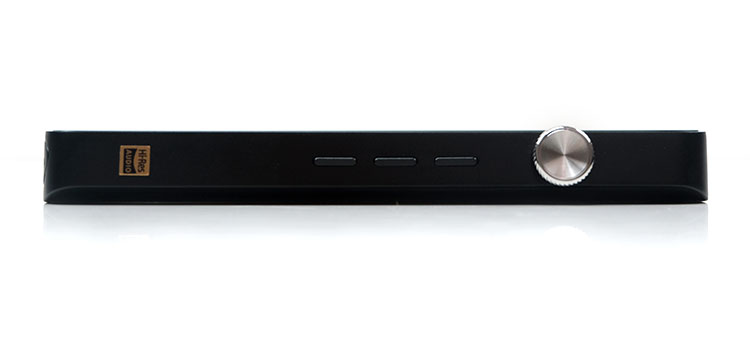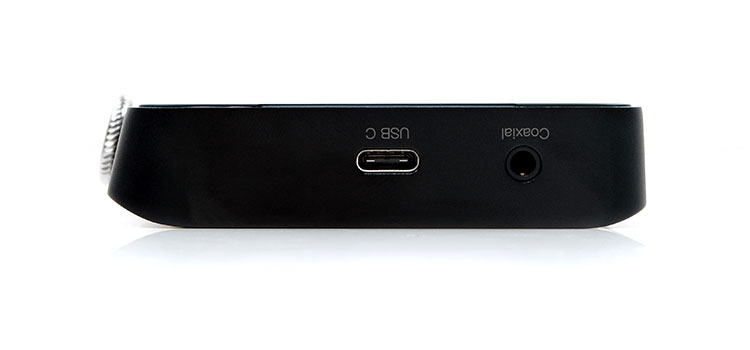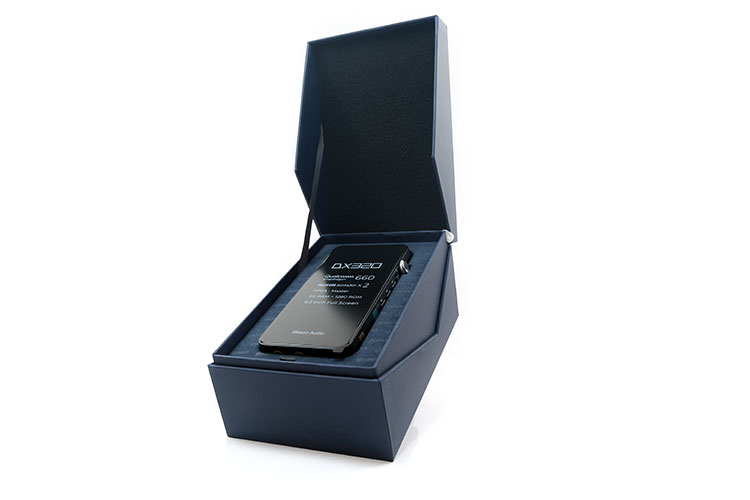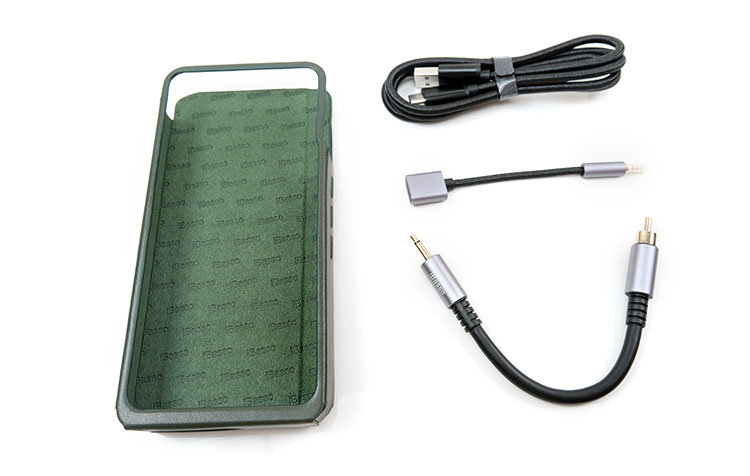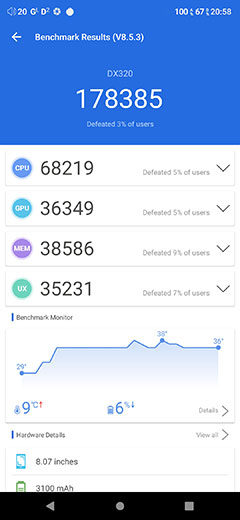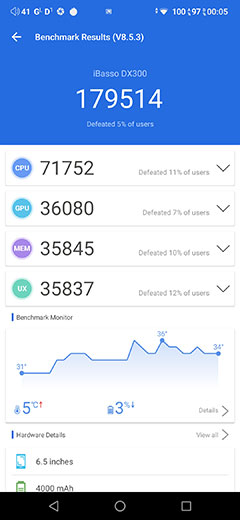I/O
The digital I/O is fixed on the DX320 and in its typical position on the top panel including a USB-C and a mini coaxial output.
The USB-C output will take care of data transfer, charging, OTG, and USB-DAC duties. The coaxial output will give you up to 24BIT/384kHz PCM and DoP DSD128 should you wish to use the DX320 as transport to another source.
To the left side you have a single microSD slot that will officially handle microSD cards of up to 2TB though personally, I keep mine to a maximum of 64GB. Onboard memory is unchanged from the DX300 at a very healthy 128GB.
All the analog I/O is on the base of the player via the swappable AMP cards so the precise configuration will vary depending on the card you use. For the stock AMP11 MK2s you get a triple balanced and SE PO and LO lineup with 4.4mm, 2.5mm, and 3.5mm, and with AMP13 you get the dual 3.5mm output for a choice of low noise and maximized output.
Controls
Physical
The DX320’s physical controls are split into two areas. The first is a slimline side panel of 3 buttons that control playback and the second, is the new slimline and properly indented silver multi-function rotary dial which controls volume, the LCD screen on and off, and power/reboot.
There are no combination techniques such as power/playback for screenshots so you will have to use an APK for that such as ‘ScreenTouch’ which is my app of choice.
As with the DX300, the DX320 side buttons have no labeling system. There is a removable sticker with labels applied out of the box which you can choose to keep attached or take off though.
I would still say also there is a case for the ease of accidentally pressing the side buttons given their positioning is right where you would grip the DX320 when picking it up or putting it down.
Touch
The rest of the control system is done entirely through the touch panel options as well as some wireless options. The touch experience of the DX320 is excellent with an instant response, double-tap to wake controls, multi-touch gestures, and that big IPS screen for big-fingered users.
Aside from that, the touchscreen will do everything you need the DX320 to do outside of initiating volume control and power on/off. You can however increase or decrease volume control via the touchscreen once initiated through the physical dial.
The mix of a decent Snapdragon 660s CPU combined with 6GB of RAM means the DX320 touch controls have virtually no lag feeling quite snappy including the obligatory pinch and zoom multi-touch features where applicable.
Those worried if the supplied screen protector will affect the IPS panel touch performance can relax as the performance felt largely unaffected when applied correctly.
Battery Life
The DX320 dual battery system remains unchanged from the DX300 which means a split with a 4000 mAh 3.8V lithium-ion polymer battery for its digital side and a 2000 mAh 3.8V lithium-ion polymer battery for its analog stage. You will see that split reflected in the top icon bar, (A & D), with 2 battery percentages on the far right.
Both batteries are QC3.0 and PD3.0 compatible for quick charging and here I would suggest you get one that is rated around 20W or higher because the DX320 is quite slow for a regular charge, particularly from a laptop USB-A output.
The DX320 battery life with the new stock AMP11 MK2s is rated a bit lower than the DX300 with AMP11 MK1 at 10 hours average continuous playback time compared to 15 hours. Of course, how you use the DAP will affect that but it’s a bit lower than I would have liked.
Also, since there are two unique batteries covering both digital and analog they will drain at slightly different rates. Typically, I find the digital side to drain faster than the analog battery if the DAP is turned on since it is a continuous drain whereas you may not always be listening to audio and draining the analog battery side.
AMP13 will drain the analog amplifier a bit faster than the stock AMp11 MK2s so you are less likely to see a big difference in the drain values of each battery. One thing to note is to upgrade the firmware which seems to have a positive effect on the balance between the analog and digital battery drain levels.
Packaging & Accessories
iBasso has used a split box package with a silver and blue design for the DX320 relatively similar to the DX300 retail ensemble. It is professional, looking, relatively simple to unpack, and offers decent protection for the contents.
The internal is fashioned much like a display stand similar to the old DX80 packaging from a few years back. The contents are layered or stacked so the DAP is on display at the top layer and all accessories tucked underneath in the lower layers.
Accessories are consistent with the previous DX300 release with the inclusion of a USB-C to USB-A charging and data transfer cable, dummy load burn-in cable, and a SPDIF to coaxial conversion short IC.
You also get 2 screen protectors one of which is tempered glass and the other a soft film type application which are not pre-applied.
The final accessory is a green soft leather carry case which I find to be much better in fit and finishing compared to the older looser blue case from the DX300. Also, if you fit the screen protector on the DX320 it will not catch the top of the case either when sliding it on.
AMP 13 Accessories
If you buy the AMP13 you will also get a fairly large grey rectangular retail box, a Torx T3 screwdriver, and a nice hard shell zippered black carry case similar to the one that comes with the AMP12 previously.
The package does come with the AMP13 already static bag wrapped inside the case and it does fit quite neatly. I suspect you could house an additional card there without any issues if you keep all cards in static bags.
The carry case’s outer is a tinplated steel facade so it retains its rigidity quite well with enough stretch from the central fiber zip lock. Think of it as a mini hard shell travel case and you are not too far off on how it works.
The final additional carry case accessory in the AMP13 package is less of a surprise considering the AMP12 had something similar. However, this time we have a low-profile silicone case which is a welcome addition considering many DX300 users reverted to tight-fitting silicone cases after finding the stock blue leather case was too loose.
Software Impressions
Android 11
Pretty sure this is the first time I have seen a DAP using Android 11 as its core OS. We have had a few now on Android 10 including the FiiO M17 and Shanling’s latest M9 flagship DAP but this is the first that I know of that shares the same OS version as my recently purchased budget smartphone.
Where once DAPs were pretty far behind, we now have parity in part with some smartphones and not that far behind either with the Snapdragon 660 CPU combined with 6GB of LPDDR4X RAM.
The DX320 Android OS is not alone either. As with the DX300, it retains its dual-boot architecture with the alternative audio-focused Mango OS complete with the recently refreshed design.
The internal CPU clock range is unchanged from the DX300 at 633.6 – 2208.0 MHz which is a significant step up from the older DX2XX series Arm Cortex performance and matches the likes of the Android 9 HiBy R8 which uses the same CPU.
Compared to the FiiO M17, the DX320 range is a little bit wider with the FiiO flagship DAP operating between a higher but narrower 1843.2 – 2208.0 MHz despite also using the same Snapdragon 660 CPU.
Out of the box, there is no Google Play installed by default so you will have to use the likes of APK Pure to download a version and from there update it. It does work thankfully so no app service-related issues with dependent apps such as Hi-Fi Cast.
For apps that are region-specific, I would still recommend using APK Pure combined with a VPN to log in one time to the likes of TIDAL.
Performance
With a light dash of app installations, the DX320 AnTuTu score holds up just as well as the original DX300. No surprise there to be honest with the same RAM and CPU setup.
It is a bit behind the Shanling M9 which I believe has the best CPU in the DAP market right now with the Qualcomm Snapdragon 665.
Otherwise, I would say the benchmarking now is very consistent with any DAP that uses the Snapdragon 660 CPU. The user experience should be almost the same in terms of response rate, smooth scrolling, and multi-tasking.
A few observational notes during the testing between the DX300 and the DX320. The DX300 AnTuTu test finished a little quicker despite it being started about half a second after the same DX320 test.
There is a very minor difference in the AnTuTu score between them but it’s nothing I would look twice at and well within the margin of error for these tests. My hunch here is that Android 11 might be more intensive on the CPU compared to Android 9 despite taking up to 2GB less system space.
Click on page 2 below for I/O, controls, and software performance
Click on page 3 for software changes and wireless performance






